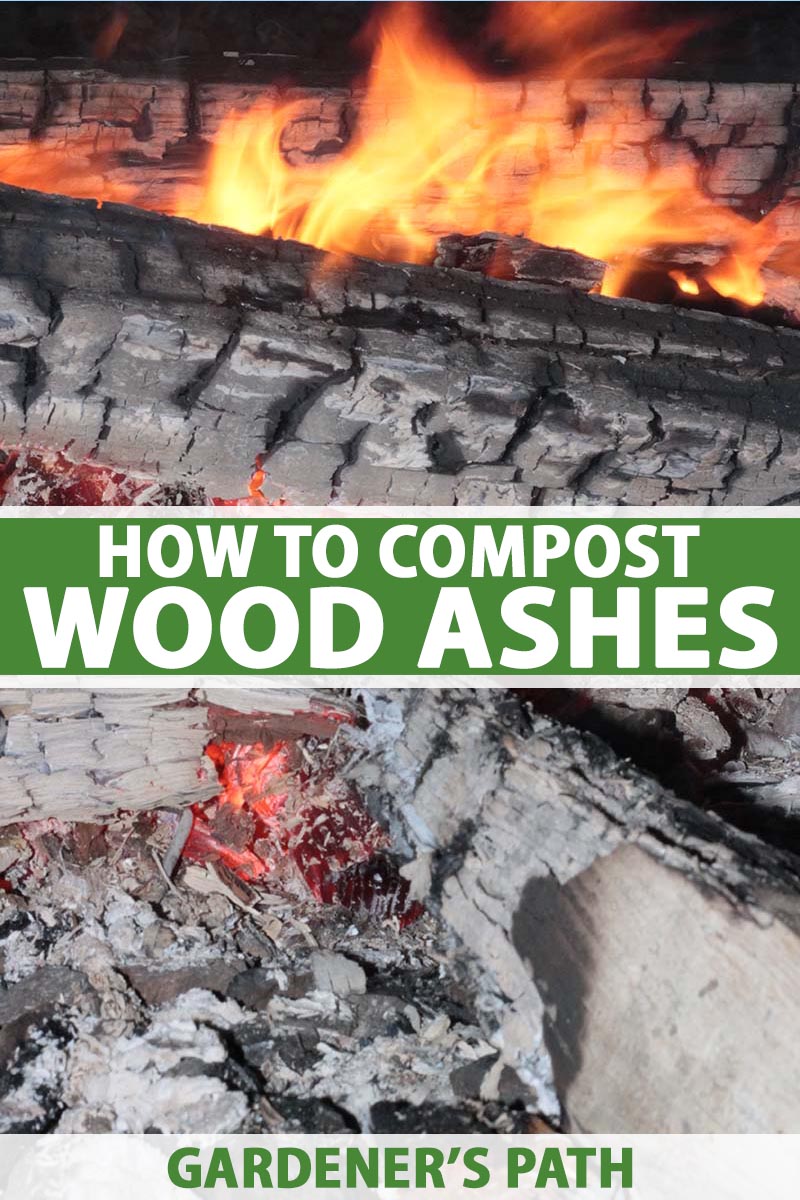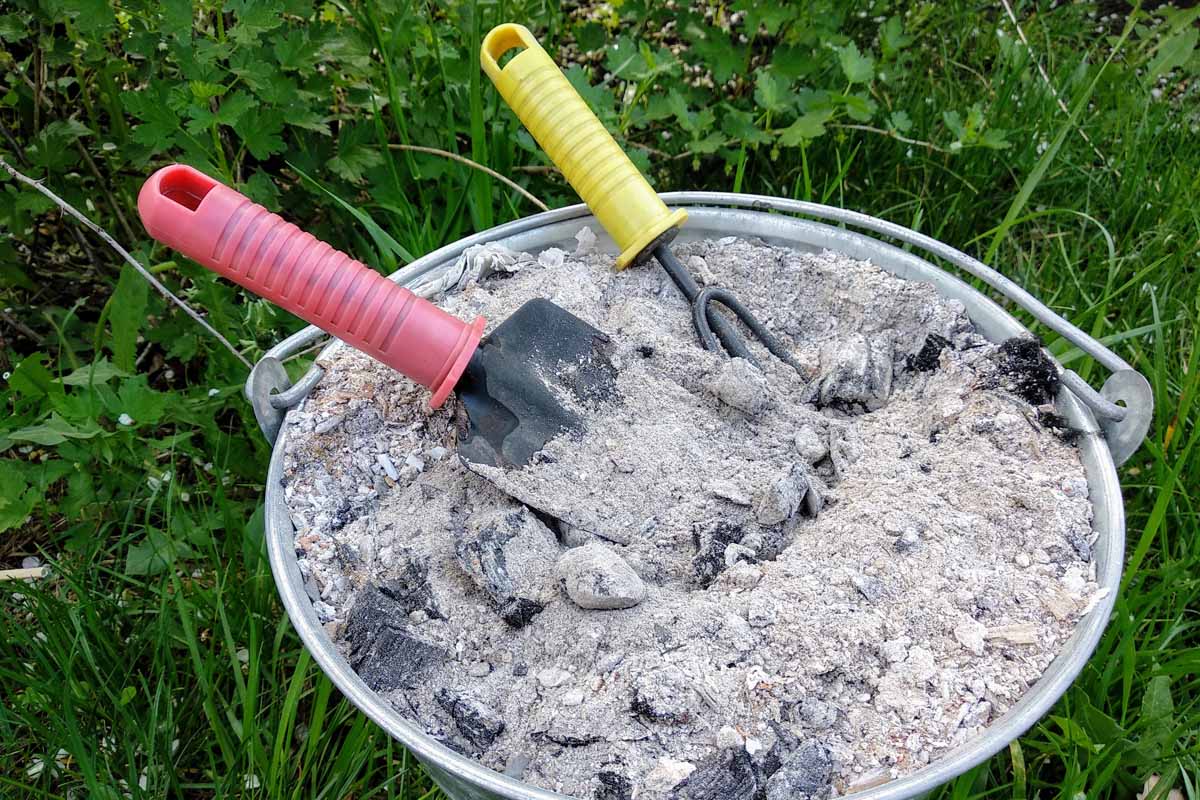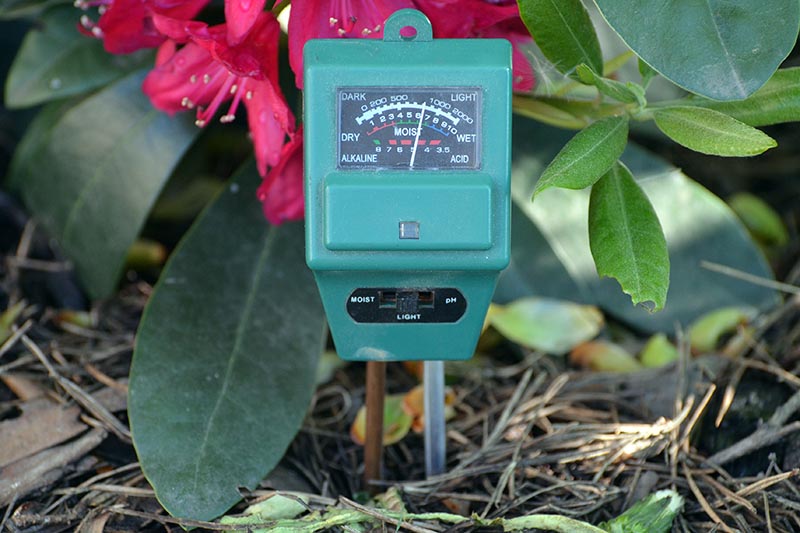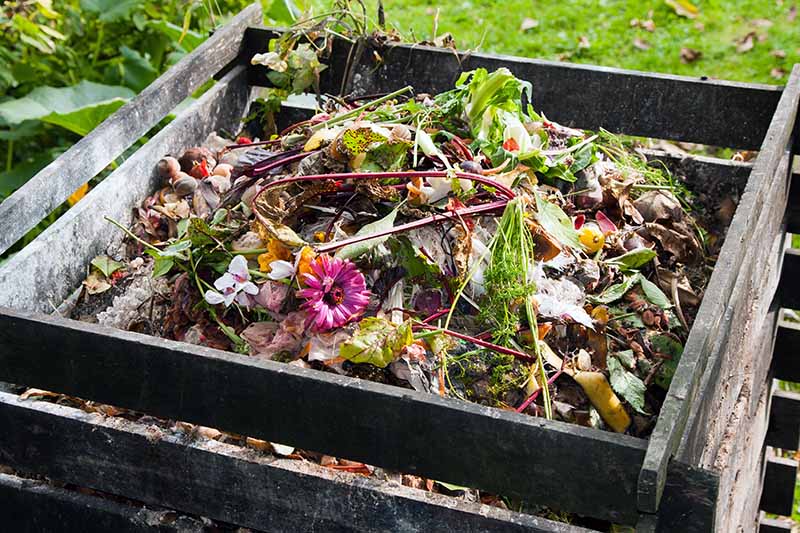Up here in Vermont, the winters are long.
For me, this means months spent curled up by the wood stove with a book and a cat on my lap.
It also means the creation of a lot of ash – which always leads me back to the question of whether or not I can compost ashes.
As it turns out, the answer is yes, with a couple of crucial caveats.

We link to vendors to help you find relevant products. If you buy from one of our links, we may earn a commission.
This article will explore how to use wood ashes in the compost and in your garden, and when it is appropriate to do so.
What You’ll Learn
Benefits of Wood Ash
Wood ash from your fireplace contains a number of nutrients that can be very beneficial to a garden – in the right circumstances.
But never use the ash from charcoal, trash fires, or treated wood, which can contain toxic chemical residue from additives.
Wood ash contains potassium and calcium in considerable quantities, as well as lesser amounts of magnesium and phosphorus, and micronutrients such as copper and zinc.

Due to its high level of calcium, it can increase the pH of soil, making it an ideal natural substitute for lime, an amendment often used to balance soil that is too acidic.
It can be a very useful amendment where acidity is too high for growing most veggies, in a pH range of 6.0 and below.
But you’ll need to be cautious. If the soil is already neutral or alkaline, adding ashes will cause excess alkalinity and add soluble salts, ultimately doing more harm than good.
So how do you know when it makes sense to add ashes to your compost or garden?
Let’s explore.
Test Your Soil
Before adding ashes (or any other amendment, for that matter) to your garden, be sure to get your soil tested!
You can easily request a test through your local agricultural extension office.
You can buy home pH and soil test kits or pH meters at your local hardware store or online, though I would recommend getting a test from your local extension office at least once.
The results of these tests are more comprehensive and they will tell you a whole lot about your soil, including information about any other nutrient deficiencies.

If you don’t have access to professional testing or a kit, it is possible to DIY a basic test of the pH with just two cups full of soil, some vinegar, and some baking soda.
Pour vinegar into the first cup. If the soil begins to fizz, it is alkaline.
Add some water to moisten the soil in the second cup, then add baking soda. Fizz this time means it is acidic.
This method is not especially accurate, and you won’t be able to determine the exact pH level of your soil this way. It is still a good idea to get a more accurate test when you are able.
In the meantime, however, this simple method should at least give you a general sense of whether the soil is acidic or alkaline.
When to Compost: Timing and Moderation
The key is to add small amounts of cooled ashes to a new or uncooked pile. Because it has such a high pH value, it is important that you don’t add too much to your compost.
According to Olivia Saunders, Extension Field Specialist in Food and Agriculture at the University of New Hampshire Extension, “it should not make up more than 5% of your compost.”
Additionally, once the compost nears maturity, the addition of ash could raise the pH too much, increasing the bioavailability of heavy metals to harmful levels.
How to Compost
Before you start, be sure to suit up with gloves, eye protection, and a mask to avoid any potential irritation to the skin, eyes, or lungs. Also, ensure that the ashes have completely cooled before handling them.

Sprinkle the ash onto your compost pile along with the appropriate ratio of brown and green material.
What does this mean? Add about a quarter inch for each 18-inch section of browns and for every six inches of greens. Be sure to turn the pile each time you add new material.
As a reminder, browns include carbon rich materials such as straw, hay, and dried leaves, while greens are more nitrogen heavy items such as kitchen scraps and fresh grass clippings.
To learn more on the basics of composting, check out this article.
If you have a hot compost pile, add a small amount of ash along with other new materials every month or so while it is active.
If the pile is cold or rarely added to, only add ash in the fall or late summer, allowing time for everything to break down before being used in the garden during the growing season.
You can collect ashes and store them in a covered container through the winter.
Adding It Directly to the Garden
If you have determined via a test that your pH is low – below 6.5 – you can also choose to add ashes directly to the garden to reduce acidity.

Incorporating ashes can also increase the bioavailability of potassium, phosphorus, and various micronutrients, thereby increasing fertility.
A Note of Caution:
Never mix ashes with nitrogen fertilizer, it can cause a reaction that releases ammonia gas. Always wear eye protection, a face mask, and gloves when handling wood ashes.
Spread on calm days to prevent it from blowing around and scattering to unwanted areas – including all over your clothes.
Apply in moderation, lightly dusting a small amount on the garden surface and working it into the soil several inches deep with a fork.
According to Rosie Lerner, Horticulture Specialist at Purdue University, “Acidic soils (pH less than 5.5) will likely be improved by wood ash addition.
Soils that are slightly acidic (pH 6.0 to 6.5) should not be harmed by the application of 20 pounds per 100 square feet annually, if the ash is worked into the soil about six inches or so.”
Be sure to test the soil again the following year. You can reapply if the pH is still too low, but if it has reached 6.5, don’t add any more. If you raise the pH too much, this can deplete the bioavailability of essential nutrients.
Do not apply to acid-loving plants such as blueberries, rhododendrons, or azaleas.
Continue to test your soil every few years and amend as necessary.
Ashes to Dust
While it is never wise to dump a whole bucket on your compost or in the garden beds, used in moderation with careful planning and an understanding of your soil, wood ashes can be repurposed as a useful amendment.

Though my wood stove churns out far more than I can safely use each winter, I am still able to recycle much of it back into my compost.
Have you used wood ashes in your garden? Please share your experience in the comments below!
If you enjoyed this article, you can learn more composting tricks in these guides:

After buying a new property I wanted to rid myself of an ugly burn pile that looked to have had years of use. I carted away wheelbarrow after wheelbarrow of ash then finally realized it went too deep to keep doing that, plus I am 73 and no longer have energy for heavy labor. I filled it with composted manure, left it for a year, and then this spring planted it with marigold seeds. They seem to be thriving so far. I don’t know if this counts as using wood ash or not but it was my remedy.
I put wood ash in my garden wherever I plant sweet corn. Till it in and plant. It helps keep pesky root loving worms away from the seeds and roots of the plants.
HI, Please advise people to never take ashes directly from the fire pit, fireplace etc and into a compost heat. It can start a fire.
Hi Louise, thank you for the feedback, you’re quite right, hot wood ashes on a compost pile would be very dangerous!
I am using wood ash on a stand of knotweed that I have been working on eliminating for the past 2 years. So far, so good. I know it works well on weeds in the gravel driveway.
I use the ash from our backyard fire pit to sprinkle around my yard every fall, just before the first snowfall. Seems to keep my plants pretty happy. I think I will add a small amount to my compost bin this time to see if there is any benefit.
Thanks for sharing! Let us know how it goes.
I love adding weeds to my compost bins, but NOT of they are in the seeding stage or if they look diseased. I BURN those… but can I THEN add the ash to my compost bins?
Hello Annie. This is a little tricky… Sometimes weeds are so evolved that they only incur a bit of visible infection, so it may be more difficult than you think to sort the ones that need to be burned from the others. Also, once the seeds are beneath the soil (or in the compost), heat won’t necessarily kill them. But with that said, it sounds like you are carefully separating the weeds that you plan to burn. So if you follow the other precautions in the article, it should work to add wood ash from burned weeds to your compost.… Read more »